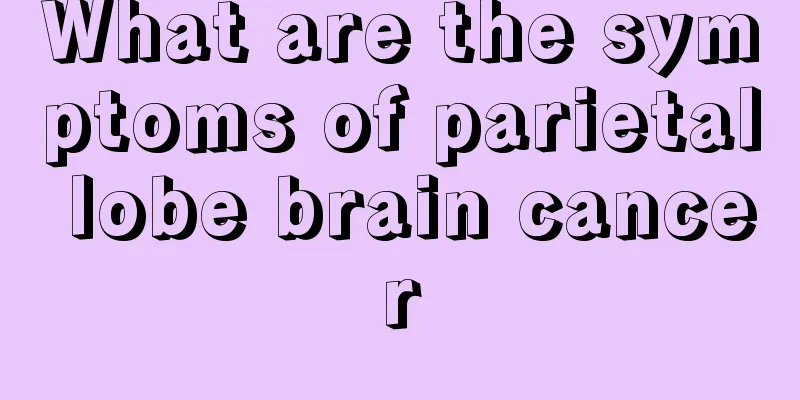What are the symptoms of parietal lobe brain cancer

|
What are the symptoms of parietal lobe brain cancer? The damage of parietal lobe tumors is mainly manifested as sensory disturbances on the opposite side of the body. Most patients may have certain symptoms and signs, especially with localized sensory epileptic seizures. Then, we will introduce the specific symptoms of parietal lobe brain cancer below: The damage caused by parietal lobe tumors is mainly manifested as sensory impairment on the opposite side of the lesion, and affects functions such as vision and language. 1. Sensory disturbance; sensory disturbance is divided into general sensory disturbance and cortical sensory disturbance. The general pain and temperature disturbance caused by parietal tumors is not obvious. Even if it occurs, it occurs at the distal end of the limbs, presenting as very mild glove or sock-type sensory disturbance. This is caused by the thalamus also receiving some pain and temperature impulses. Cortical sensory disturbance is mainly manifested as the disturbance of position sense, two-point discrimination, tactile positioning and pattern sense of the limbs on the opposite side of the lesion. For example, when the patient closes his eyes, although he can feel the object held in his hand, he cannot judge the weight, size, shape, texture, etc. of the object, and even cannot recognize simple numbers written on the skin. Therefore, he cannot complete the comprehensive analysis of the object, which is called loss of solid sense. This is the result of extensive damage to the superior lobule of the postcentral gyrus. Cortical sensory disturbance can also manifest as sensory neglect. When the affected limb is stimulated, the sensation may be completely normal or slightly reduced. If both limbs are stimulated at the same time, only the healthy limb will be felt, and the affected limb will be completely ignored. When the factors that stimulate the affected limb have been removed, the patient still feels the stimulation for a period of time, which is called tactile retention. 2. Body image disorder; patients have difficulty recognizing their own body structure. This phenomenon is especially common in right parietal lobe lesions, and the mechanism of its occurrence has not yet been fully understood. There are many clinical manifestations, such as the patient's indifference to his own hemiplegia, not paying attention, as if it has nothing to do with him, and no anxiety, which is called hemiplegia agnosia. The patient completely denies his hemiplegia, and even when the paralyzed limb is shown to the patient, he firmly denies that it is his own limb. Sometimes he thinks it is someone else's hand or foot, or explains the reason why the limb cannot move with irrelevant reasons. This phenomenon is called hemiplegia agnosia. Some patients have a feeling of losing their limbs, thinking that their limbs no longer exist, the paralyzed limbs are not their own, and their limbs have been lost. Another manifestation is the feeling that there are one or more limbs, which is called phantom polylimbia. In addition, some patients have finger agnosia, left and right body orientation disorders, autoamnesia, etc. 3. Astructuropathy: Astructuropathy is also called structural apraxia. It refers to the inability to correctly recognize and distinguish the spatial relationships of spatial objects, architecture, paintings, patterns, etc., the inability to combine, the inability to understand the relationship between each other, and the inability to correctly use tools to work, which makes life difficult. Clinically, it can be examined by drawing, building blocks, etc. Although the patient can imitate, and the various components seem to be there, they lack the ability to layout and the proportional relationship, or they are upside down, left and right, and the arrangement is too crowded or scattered, losing the original shape, without the concept of space, and lacking three-dimensional relationships. There is no consensus on the mechanism of astructuropathy. 4. Gerstmann syndrome: seen in the angular gyrus and supramarginal gyrus of the posterior and inferior parietal lobe, as well as lesions in the transitional area of the parietal lobe to the occipital lobe, the clinical manifestations are mainly finger agnosia, left-right disorientation, agraphia, and acalculia. Finger agnosia is the most common and often bilateral. When the patient is asked to show a designated finger, the finger cannot be identified and the finger use is confused, especially the thumb, little finger, and middle finger. Finger agnosia is an important part of Gerstmann syndrome. Left-right disorientation is not only the inability to distinguish left from right when identifying the limbs of oneself but also of others, but it does not necessarily affect the left-right orientation of the surrounding environment. Agraphia is mainly manifested as difficulty in writing, but there is no difficulty in reading or copying. Acalculia is most obvious in pen calculation. 5. Dyslexia: Lesions in the parietal and occipital lobes of the left cerebral hemisphere often lead to dyslexia, which is the loss of reading ability accompanied by writing difficulties. Dyslexia can be divided into two types: (1) Subcortical alexia: The patient cannot read written or printed words and cannot pronounce, but spontaneous writing and copying are not hindered. The patient can express his thoughts through writing, but cannot read the articles or letters he wrote. Subcortical alexia is often accompanied by hemianopsia (2) Cortical alexia: In addition to not being able to recognize and read words, patients often also suffer from agraphia and are unable to follow dictation, copy, or write spontaneously. 6. Epileptic seizures: Epileptic seizures caused by parietal lobe tumors are mostly localized and often sensory, manifested as paroxysmal paresthesias on the opposite side of the lesion. The first site is usually the thumb and index finger, but it is not uncommon for the foot to start. It is mainly characterized by paroxysmal numbness, electric shock-like sensations, or pain, which spread in a fixed direction. However, it can also be motor, presenting as localized muscle spasms or clonus, or starting with sensory symptoms followed by motor symptoms, and even evolving into a grand mal seizure. There is often a sense of two-point discrimination after the onset of the seizure. Transient sensory disturbances such as solid sense and position sense 7. Hemiplegia or monoplegia: Hemiplegia or monoplegia of the contralateral limbs often occurs in parietal lobe tumors. Paralysis is not a symptom of the parietal lobe itself, but is caused by the tumor invading the motor area. At the same time as the paralysis symptoms appear, deep hyperreflexia can be seen, but the increase in muscle tension is not obvious. 8. Others: When there is a parietal lobe tumor, muscle atrophy of the limbs on the opposite side of the lesion, visual illusion caused by visual distortion, contralateral lower quarter blindness or homotopic hemianopsia, and difficulty in understanding the relationship with the geographical environment may sometimes occur. |
<<: Will brain cancer cause the head to become bigger?
>>: Can malignant brain cancer be cured?
Recommend
What to eat when you have hypoglycemia symptoms
Hypoglycemia means that blood sugar is too low, w...
Taboos after rhinoplasty with prosthesis
Many people are attracted by Western aesthetic vi...
What are the effects and contraindications of lotus leaf tea?
Nowadays, many people pay more attention to healt...
How to remove parasites from the human body
The human body needs a lot of vital energy to sup...
What is the best treatment for hemangioma plaques in the neck?
Hemangioma plaque is also commonly known as cervi...
Intestinal melanosis
Intestinal melanosis is a non-inflammatory bowel ...
A review of tongue cancer treatment methods
Tongue cancer is not common in life, so it is not...
Why do cracked teeth not need to be extracted
Teeth are the hardest part of the human body. Whe...
What are the dietary taboos for diabetes?
Diabetic patients need to pay attention to many t...
Can constipation caused by hemorrhoids lead to colon cancer?
Will constipation caused by hemorrhoids lead to c...
What are the symptoms of ovarian cancer
As the body develops, there will always be proble...
How to taste red wine
Wine culture occupies an important position in We...
How to knead the tendon bag
Tendons are densely distributed throughout the bo...
What are the common early symptoms of lung cancer? Be careful of these 4 symptoms, it may be lung cancer
For any disease, early detection and early treatm...
How much does it cost to go to the hospital to check for pituitary tumors
Nowadays, people still pay more attention to thei...









